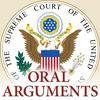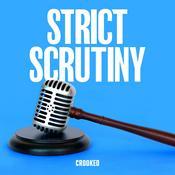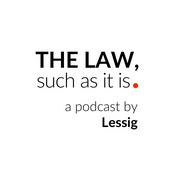458 episodes

[24-345] FS Credit Opportunities Corp. v. Saba Capital Master Fund, Ltd.
12/10/2025 | 1h 18 mins.
FS Credit Opportunities Corp. v. Saba Capital Master Fund, Ltd. Justia · Docket · oyez.org Argued on Dec 10, 2025. Petitioner: FS Credit Opportunities Corp.Respondent: Saba Capital Master Fund, Ltd. Advocates: Shay Dvoretzky (for the Petitioners and BlackRock Respondents supporting the Petitioners) Max E. Schulman (for the United States, as amicus curiae, supporting the Petitioners) Paul D. Clement (for the Saba Respondents) Facts of the case (from oyez.org) Investment funds organized as closed-end mutual funds under Maryland law adopted “control share provisions” that stripped voting rights from shareholders who owned 10% or more of a fund’s shares. These provisions were adopted in response to activist investor Saba Capital, which had been acquiring large positions in underperforming closed-end funds with the goal of unlocking shareholder value through various strategies, including electing new directors and advocating for share buybacks. Saba Capital sued sixteen closed-end funds in June 2023, seeking rescission of these control share provisions. Saba argued that the provisions violated Section 18(i) of the Investment Company Act (ICA), which requires that “every share of stock shall be a voting stock and have equal voting rights with every other outstanding stock.” Saba brought its lawsuit under Section 47(b) of the ICA, relying on Second Circuit precedent that recognized an implied private right of action for parties seeking to rescind contracts that violate the ICA. The U.S. District Court for the Southern District of New York granted summary judgment in favor of Saba against eleven of the funds (five were dismissed due to forum selection clauses requiring suit in Maryland). The district court held that the control share provisions violated the ICA’s equal voting rights mandate and ordered their rescission. The U.S. Court of Appeals for the Second Circuit affirmed this decision in a summary order. Question Does Section 47(b) of the ICA, 15 U.S.C. § 80a-46 (b), create an implied private right of action?

[24-872] Hamm v. Smith
12/10/2025 | 2h 1 mins.
Hamm v. Smith Justia · Docket · oyez.org Argued on Dec 10, 2025. Petitioner: John Q. Hamm, Commissioner, Alabama Department of Corrections.Respondent: Joseph Clifton Smith. Advocates: Robert M. Overing (for the Petitioner) Harry Graver (for the United States, as amicus curiae, supporting the Petitioner) Seth P. Waxman (for the Respondent) Facts of the case (from oyez.org) Joseph Clifton Smith was convicted of capital murder and sentenced to death in Alabama. Years later, Smith filed a federal habeas corpus petition under 28 U.S.C. § 2254, seeking to overturn his death sentence on grounds that he is intellectually disabled and therefore cannot be executed under the Eighth and Fourteenth Amendments. The central issue in Smith’s case involved determining whether he met the three-prong test for intellectual disability: significantly subaverage intellectual functioning, significant deficits in adaptive behavior, and manifestation of these qualities before age 18. Smith's IQ testing revealed multiple scores—72, 74, 75, 74, and 78—that fell within or near the range associated with intellectual disability when accounting for standard error of measurement. His experts testified that four of his five scores were consistent with mild intellectual disability, while the state’s expert, Dr. King, argued that Smith’s multiple scores placed him in the borderline range just above intellectual disability. After extensive evidentiary hearings featuring competing expert testimony about both Smith’s IQ scores and his adaptive functioning deficits, the district court found Smith intellectually disabled. The U.S. District Court for the Southern District of Alabama granted Smith’s habeas petition and vacated his death sentence. The U.S. Court of Appeals for the Eleventh Circuit affirmed this decision, but the Supreme Court granted certiorari and remanded the case, asking the Eleventh Circuit to clarify whether its ruling relied solely on the lower end of Smith's IQ score range or on a holistic analysis of all evidence. On remand, the Eleventh Circuit explained that its reasoning was based on a holistic analysis. Question When a capital defendant has taken multiple IQ tests with varying results, how should courts evaluate the cumulative effect of those scores to determine whether the defendant has significantly subaverage intellectual functioning under Atkins v. Virginia?

[24-621] National Republican Senatorial Committee v. Federal Election Commission
12/09/2025 | 2h 10 mins.
National Republican Senatorial Committee v. Federal Election Commission Justia · Docket · oyez.org Argued on Dec 9, 2025. Petitioner: National Republican Senatorial Committee.Respondent: Federal Election Commission. Advocates: Noel J. Francisco (for the Petitioners) Sarah M. Harris (for the Respondents, supporting the Petitioners) Roman Martinez (Court-appointed amicus curiae, supporting the judgment below) Marc E. Elias (for the Intervenors) Facts of the case (from oyez.org) In 2022, two Republican party committees—the National Republican Senatorial Committee and the National Republican Congressional Committee—along with then-Senator J.D. Vance and then-Representative Steve Chabot, sued the Federal Election Commission (FEC). The Republican committees asserted that the Federal Election Campaign Act of 1971 (FECA) unconstitutionally restricts their ability to coordinate campaign advertising with their own candidates. This coordination allows the party and its candidates to unify their political message and spend money more efficiently. For example, in the 2021-2022 election cycle, the senatorial committee spent about $15.5 million and the congressional committee spent about $8.3 million on such coordinated expenditures, which primarily fund political advertising. The plaintiffs argue that developments since a 2001 Supreme Court decision, FEC v. Colorado Republican Federal Campaign Committee (Colorado II), which upheld these same limits, have rendered that decision obsolete. Specifically, they point to changes in campaign finance law, the rise of “Super PACs,” and shifts in the Supreme Court’s First Amendment jurisprudence as reasons the restrictions no longer pass constitutional muster. The plaintiffs filed their lawsuit in the U.S. District Court for the Southern District of Ohio. As required by FECA for constitutional challenges, the district court certified the legal question to the U.S. Court of Appeals for the Sixth Circuit sitting en banc. The Sixth Circuit concluded that the FECA’s limits on coordinated campaign expenditures do not violate the First Amendment and denied both the facial and as-applied challenges brought by the plaintiffs. Question Do FECA limits on coordinated party expenditures in 52 U.S.C. § 30116 violate the First Amendment, either on their face or as applied to party spending in connection with “party coordinated communications”?

[25-332] Trump v. Slaughter
12/08/2025 | 2h 30 mins.
Trump v. Slaughter Justia · Docket · oyez.org Argued on Dec 8, 2025. Petitioner: Donald J. Trump, President of the United States, et al.Respondent: Rebecca Kelly Slaughter, et al. Advocates: D. John Sauer (for the Petitioners) Amit Agarwal (for the Respondents) Facts of the case (from oyez.org) Rebecca Kelly Slaughter was serving as a Commissioner on the Federal Trade Commission (FTC), an agency led by five commissioners appointed by the President and confirmed by the Senate to seven-year terms. The Federal Trade Commission Act limits the President’s ability to remove an FTC Commissioner to “inefficiency, neglect of duty, or malfeasance in office.” President Donald J. Trump fired Commissioner Slaughter, explaining her continued service was “inconsistent with [the] Administration’s priorities,” which did not meet the statutory standard of “cause.” Slaughter sued President Trump and the three remaining FTC Commissioners, arguing her removal was unlawful because the President failed to offer a statutory cause. The district court ruled in favor of Commissioner Slaughter, declaring her removal unlawful, ordering her reinstatement, and issuing a permanent injunction against the remaining Commissioners and their subordinates, barring them from interfering with her duties. The government appealed the decision and requested a stay of the district court's order pending the appeal. The U.S. Court of Appeals for the D.C. Circuit denied the government’s motion for a stay pending appeal and dissolved an administrative stay that had been previously entered. The Supreme Court granted the stay on September 22, 2025, and also granted certiorari. Question Do the statutory removal protections for members of the Federal Trade Commission violate the separation of powers?

[24-993] Olivier v. City of Brandon
12/03/2025 | 1h 24 mins.
Olivier v. City of Brandon, Mississippi Justia · Docket · oyez.org Argued on Dec 3, 2025. Petitioner: Gabriel Olivier.Respondent: City of Brandon, Mississippi, et al. Advocates: Allyson N. Ho (for the Petitioner) Ashley Robertson (for the United States, as amicus curiae, supporting vacatur) G. Todd Butler (for the Respondents) Facts of the case (from oyez.org) Gabriel Olivier was an evangelical Christian who regularly preached in public using signs and loudspeakers to convey religious messages. Between 2018 and 2019, he evangelized several times outside the Brandon Amphitheater, a city-owned venue in Brandon, Mississippi. In 2019, the city enacted an ordinance requiring protestors during live events to remain in a designated protest area, restricting use of loudspeakers and prohibiting non-handheld signs. In May 2021, Olivier returned to the Amphitheater during a concert to preach and was ordered by the police chief to move to the protest area. After briefly complying, Olivier returned to a more populated area, resulting in a citation for violating the ordinance. He pleaded no contest in municipal court, paid a fine, and did not appeal the conviction. Olivier then filed a lawsuit in the U.S. District Court for the Southern District of Mississippi, seeking damages and an injunction to prevent future enforcement of the ordinance, arguing it violated his First and Fourteenth Amendment rights. The district court held that his claims were barred by the doctrine established in Heck v. Humphrey because success on them would necessarily imply the invalidity of his still-standing conviction. The U.S. Court of Appeals for the Fifth Circuit affirmed, modifying the dismissal to be with prejudice only until the conditions set by Heck were met. Question Does Heck v. Humphrey bar Section 1983 claims for purely prospective relief when the plaintiff has already been punished under the challenged law, and does that bar apply even if the plaintiff lacked access to federal habeas relief?
More Government podcasts
Trending Government podcasts
About Supreme Court Oral Arguments
Listen to Supreme Court Oral Arguments, Anne Hidalgo - Paris en Commun and many other podcasts from around the world with the radio.net app

Get the free radio.net app
- Stations and podcasts to bookmark
- Stream via Wi-Fi or Bluetooth
- Supports Carplay & Android Auto
- Many other app features
Get the free radio.net app
- Stations and podcasts to bookmark
- Stream via Wi-Fi or Bluetooth
- Supports Carplay & Android Auto
- Many other app features


Supreme Court Oral Arguments
download the app,
start listening.







































